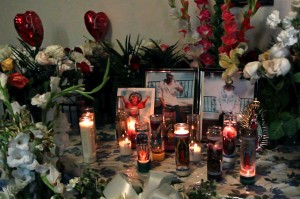
Along a desolate stretch of Webster Avenue, sandwiched between the Bronx River Parkway on one side and the vast, storied Woodlawn cemetery on the other, sits another graveyard of sorts.
The street, which starts and ends between 233 Street and Gun Hill Road, has become an ad hoc dumping ground for dozens of abandoned vehicles from recreational vans to trailers and commercial trucks. It’s considered both a menace to residents and a rest stop for truck drivers.
A time-lapse of the Webster Avenue car graveyard on September 30, 2019. © Lila Hassan
A few have parking tickets stuck onto their windshield wipers or yellow boots on their tires, indicating their impending trip to the car pound, where police officers tow discarded cars.
The Department of Transportation, Sanitation, and local Assemblyman’s office have pointed to the local 47th precinct as the responsible party for enforcing traffic regulations and removals.
None of these government agencies are sure why the cars and trucks are not being removed promptly, and none have been able to answer where they go once towed or removed. Similarly, none of these departments, including the NYPD, know why the 18-wheel truck drivers come here to park, sleep, and take breaks on days-long assignments.
Local residents are fed up.
“The block is just a dump,” said Jasmine Miranda, whose parents’ home is at one end of Webster Avenue strip. One morning in mid-August, there was no indication of abandoned vehicles and just a handful of trucks were parked.
Just one week later, there were as many as 50 vehicles scattered across the area, in defiance of alternate side parking rules. Some had their Vehicle Identification Numbers (VIN) scratched out. Others had open trunks and missing license plates and other parts. Alongside them were piles of beer bottles, takeout food containers, and even the occasional used mattress.
A week later, the same sad collection of cars and trucks were still there. Eventually some trash was removed, and several cars were towed, only for more cars to come in their place.
“Companies park their trucks there in the evening. There are RVs, trash everywhere. It’s kind of an abandoned area,” said Shawn Guffey, board member at the Woodlawn Taxpayers Association, a local not-for-profit community organization. Woodlawn is the neighborhood at the north end of the car graveyard.
The Association first heard of the issue at one of its monthly open meetings when a community member complained about the street being full of trucks and trailers.
The New York Police Department’s 47th precinct, whose sector covers the entire strip on Webster Avenue and is responsible for ticketing and towing, said that giving summonses is useless, according to Commanding Chief, Inspector Erik Hernandez.
“They [truck drivers] would rather pay the parking summons that find storage for these trucks,” Hernandez said.
Jasmine and Theresa Miranda, 26 and 30, sisters whose parents’ home is at the other end near Gun Hill Road, view the street is an eyesore. At night, “it seems sort of ominous,” said Theresa.
Miranda recalled being spooked when she accidentally got off one subway stop too far on the Metro North at 233rd street, almost two miles away from her home on the other side of Webster Avenue. Afraid, “I basically ran that whole area in the dark,” she said.

Miranda thinks the area is deteriorating. “Honestly, I try not to park there anymore,” she said. “People abandon their cars there and even if they’re booted, it won’t be towed away for weeks.” She doesn’t think the alternate side parking rules make a difference, because the “trucks don’t normally leave. It’s long term parking.”
A “Large Parking Lot”
The alternate side street signs that stretch along the 1.5-mile strip include three signs to indicate no parking for street cleaning on Monday and Thursday mornings, as well as one for Tuesday and Friday mornings.
But just because the rules are there doesn’t mean they’re enforced.
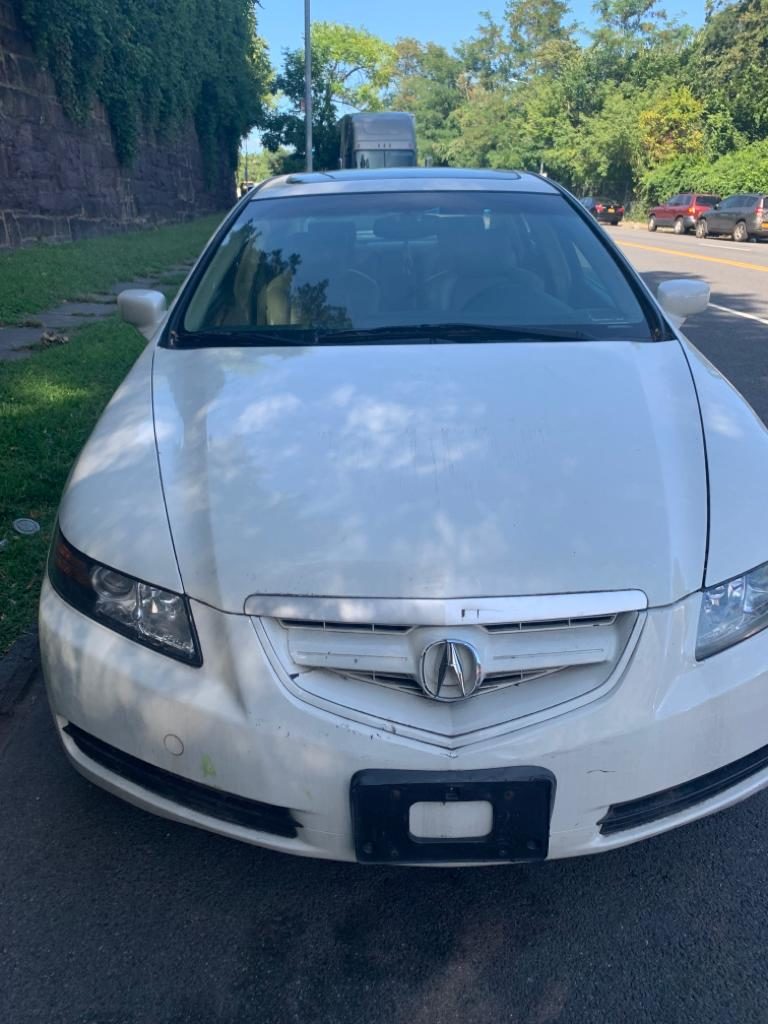
The Bronx Ink paid a visit to the Webster Avenue car graveyard on August 21 and found a white Acura with missing license plates and a printed out temporary license that hung from the inside of the back window. Over a month later on September 30, the car was found in the same illegal spot, unmoved, with trash on the street nearby it. The seats in the front were cut up, and a used battery booster was left in the backseat.
On September 30, the Bronx Ink counted 26 18-wheel trucks, five apparently abandoned vehicles, four also apparently abandoned RV’s, eight parked tow trucks, six cargo vans, five minivans, three double decker buses, two piles of at least six trash bags each, and one dead raccoon.
The alternate side parking rules were put up just earlier this year, when Assemblyman Jeffrey Dinowitz put in a request to Councilman Andrew Cohen.
Dinowitz said the Webster Avenue strip is more or less “a large parking lot.”
It’s difficult to tow big vehicles, he said. But he and his team look to “press the 47th precinct to enforce rules whenever they can.”
“They’ve been very helpful,” said Dinowitz, and “it could get better, but then it gets bad again.”
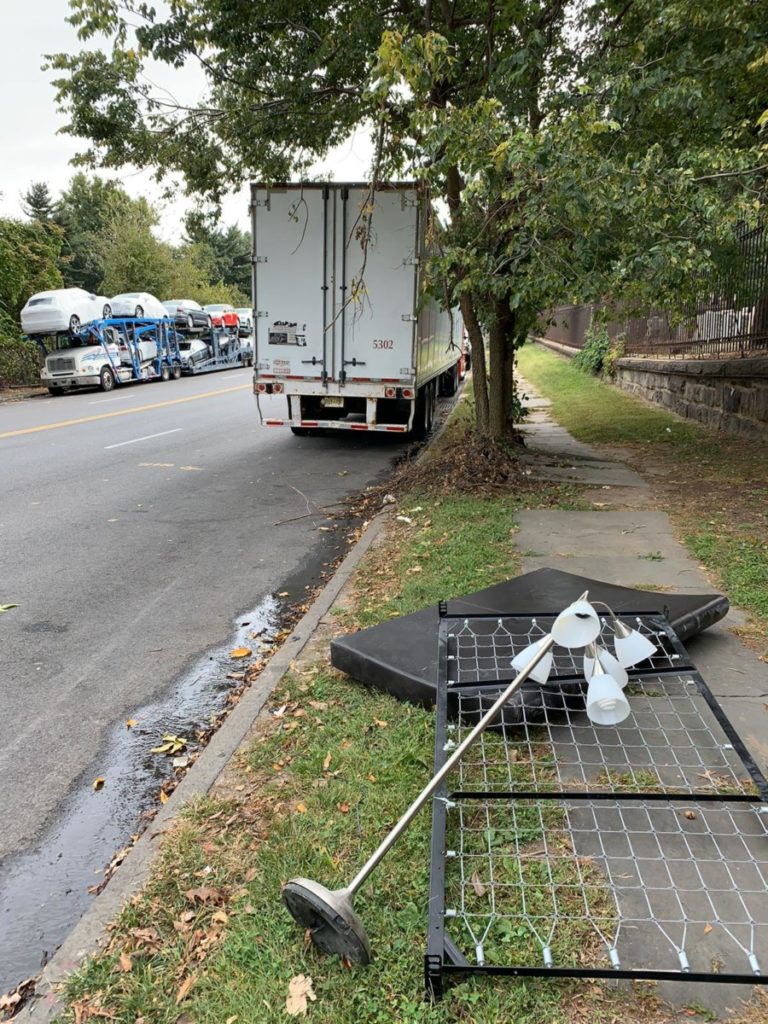
Some of the tossed out items found. © Lila Hassan 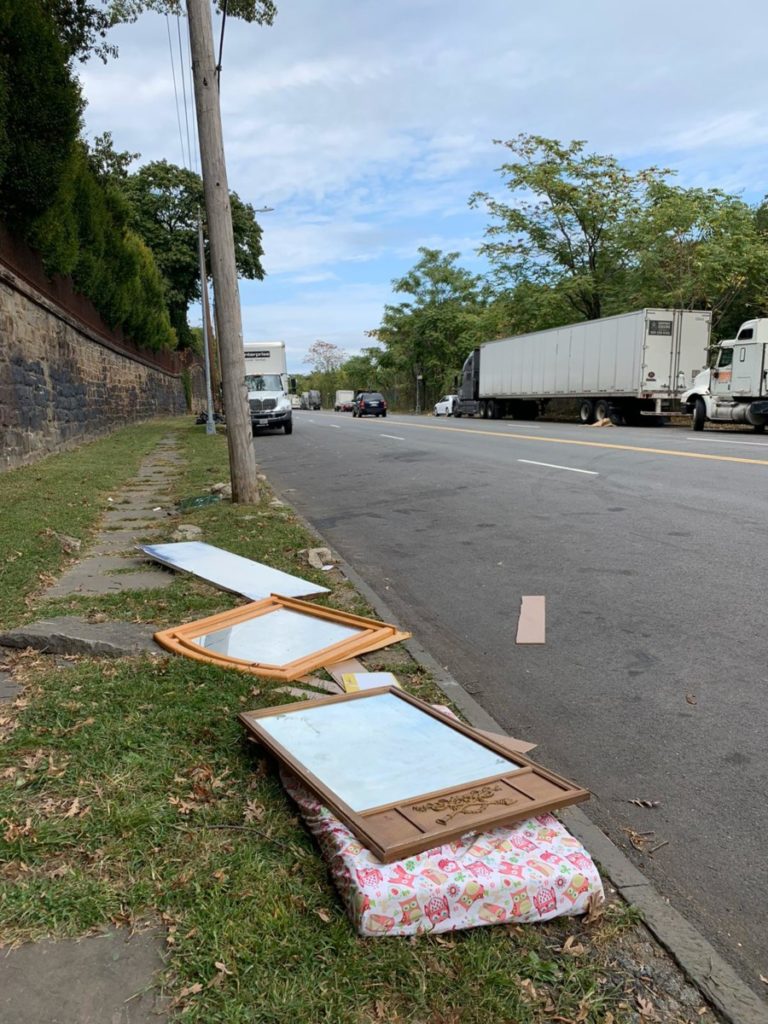

Not A “Profitable or Actionable Collection”
Because the car graveyard on Webster Avenue is located in front of the cemetery and highway with no residential homes or buildings, the street is considered city property. It is unclear why enforcement of alternate side parking rules, towing, ticketing and clean-ups there are scarce.
Amanda Septimo, former district manager for Congressman Jose E. Serrano, and a lifelong resident of Hunts Point, said there is hyper vigilance and enforcement there with a larger police presence, which is not the case in other areas of the Bronx.
“The city might be targeting neighborhoods with actively present residents and not areas where there isn’t a profit or actionable collection,” she said.
Complaints to the city don’t seem to help either. Jasmine Miranda has said that other residents have given up reaching out to the city, thinking that 311 does not respond to their calls.
“Whenever a New Yorker calls 311 or uses our website or mobile app, their service request is instantly routed to the appropriate agency for a response,” according to Laura Feyer, deputy press secretary in the Office of the Mayor.
Several of the cars on Webster Avenue are booted, which indicate that the owner has received over $350 in tickets (whether for parking violations, red light violations, or bus lane violations), according to NYC 311.
The fate after this is towing, and if the vehicle remains unclaimed, it will be auctioned off. The owner of the vehicle is responsible for all the fees in towing, moving, and auctioning, and if the auction does not pay off the tickets and fees, the owner’s bank account and wages will be accessed to pay.
However, in cases where the abandoned cars’ VIN number (the unique identification) has been damaged or removed from the car, and the owner is untraceable, the DOT said in a phone call and over email that it could not answer this question because the NYPD is the responsible party for towing, removal, and enforcement.
The police are also responsible for determining what constitutes an abandoned vehicle or unidentifiable owner. The DOT sometimes relocates vehicles blocking paving jobs, but it doesn’t actually tow them, according to Scott Gastel, assistant commissioner for press.
“Not Something That’s Not Dealt With”
The Department of Sanitation is “aware of the situation on this particular stretch of Webster Avenue,” according to Dina Montes, press secretary of public affairs at the DSNY.
From January to September, the DSNY Enforcement Unit issued 44 summonses for littering and public urination and seven summonses for illegal dumping. In September alone, the unit has issued 29 summonses for alternate side parking violations.
Problems Montes identified on the street include illegal dumping, non-compliance with alternate side parking rules, and abandoned and derelict vehicles.
The DSNY is responsible for removing only derelict vehicles, which means a vehicle has both “sustained physical damage” and is without license plates. Between July 2018 and September 2019, the DSNY removed 11 derelict vehicles. All other removals fall on the shoulders of the 47th precinct.
The 47th precinct did not provide requested statistics on the frequency of patrols, traffic violations, summonses, and tickets issued to this particular street despite many requests.
Police Officer Sherman Tyson, a Neighborhood Coordination Officer for the Woodlawn area, though not for this specific street, told the Bronx Ink that the dumping and abandoned cars are “not something that’s not dealt with,” and it is patrolled as equally as any other part of their district.
When asked what constitutes an abandoned vehicle, Tyson answered that it is a vehicle left unmoved for 48 hours, although he says this is not always enforced, and they don’t tow everyday.
“Is that a realistic expectation?” Tyson responded.
Hernandez, however, said concern with this strip is “legitimate,” but need vehicles to be flagged as problems for them to move it, otherwise they don’t know. If a car looks abandoned, he said, it doesn’t need to wait 48 hours to be removed.
In addition to the constant cycle, Hernandez said the private companies that the NYPD works with to tow – licensed by the Department of Consumer Affairs – do not have the proper storage to hold the amount of cars that need removing, especially those larger than sedans. Hernandez said the precinct can only have three or four cars towed at a time.
Moving the trucks, on the other hand, is like “spitting into a fan.”
“As soon as we two one truck another one goes there in its replacement,” he said.
Usually the precinct can remove 30-40 vehicles a month, including 5 trucks.
From January to August of this year, there have been 148 unregistered moving violations in the Bronx’s 47th Police Precinct, according to traffic violation stats obtained by the Bronx Ink, compared to 83 in the 48th precinct and 116 in the 46th.
“Nobody Bothers Us”
Cleaning his parked green 18-wheeler, truck driver Robert Caceres said that there is no commercial parking for trucks in the Bronx that are convenient, safe, and affordable.
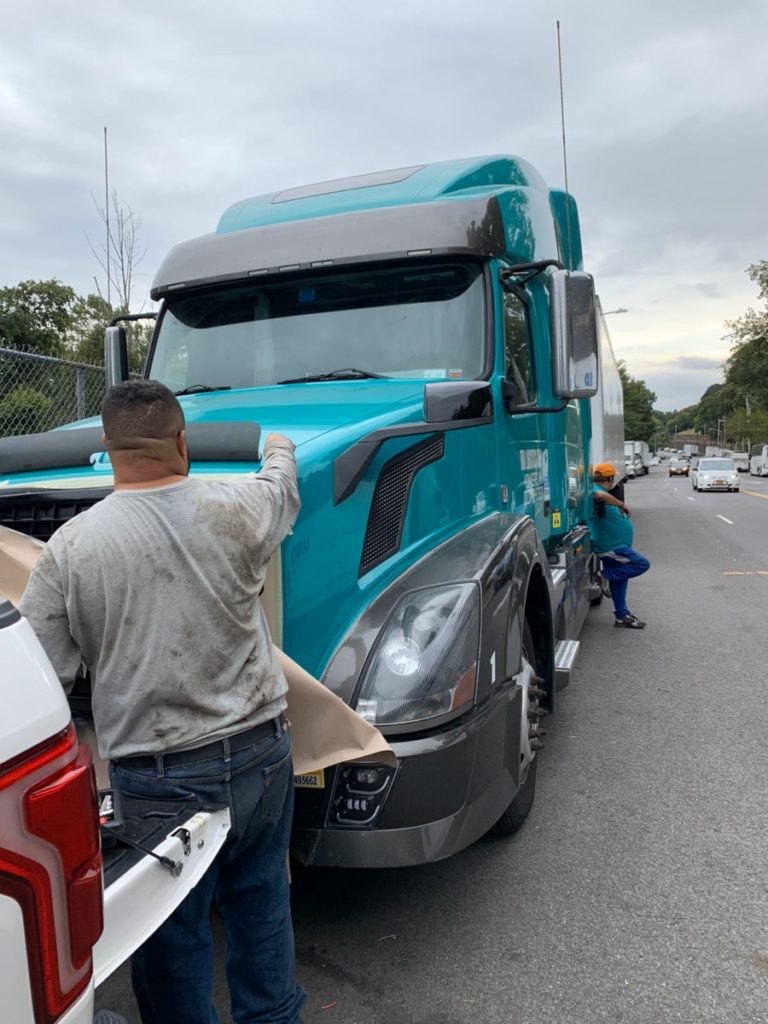
If a truck driver works for 14 hours, they are legally required to take a 10-hour break. If they are caught driving during their break, they can receive a traffic citation.
“Parking is tough out here,” Caceres said. On Webster Avenue, “we’re not in front of nobody’s building.”
Caceres owns Tod Logistics Corp. in Yonkers, a one-driver, one-truck transport company and now controls his own hours. Before he had his own business, he often worked three to five day assignments.
Behind the driver’s seat, Caceres has two beds, a microwave, and drawers of instant food he used during his break time.
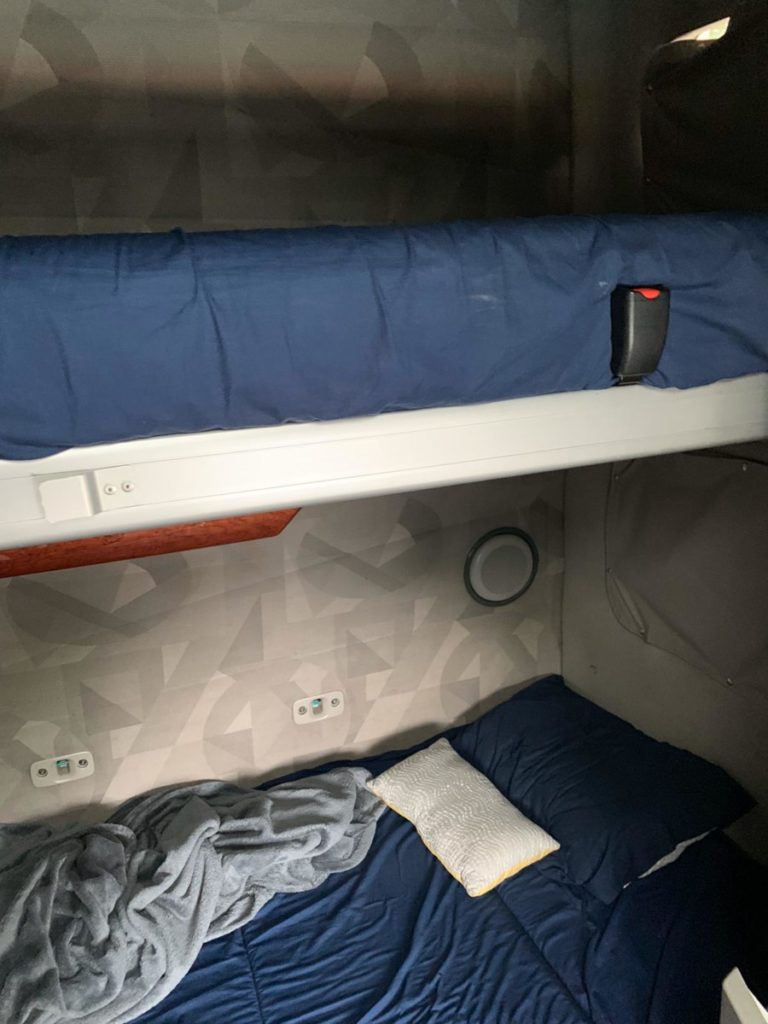
Caceres’ inside of the truck. © Lila Hassan 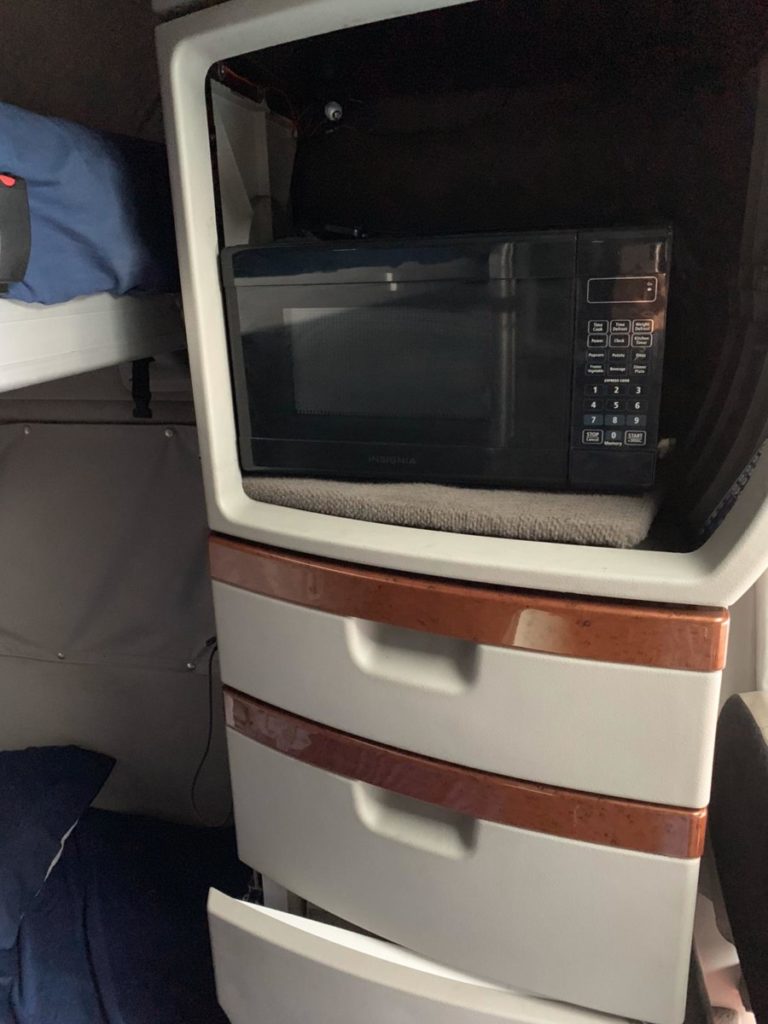
Caceres said he doesn’t know how other truck drivers know about Webster Avenue, but the strip’s view of the Metro North railroad and direct road to the Bronx River Parkway highway make the spot visible to passing drivers.
Occasionally police will ask drivers to move, he said, but they do not always feel the need to abide.
“Let’s say we’re not here. You think dumping is going to stop? There are no cops here. People will still come and sleep here regardless,” he said.
“Nobody bothers us.”



